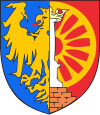Zawadzkie
| Zawadzkie | ||
|---|---|---|

|
|
|
| Basic data | ||
| State : | Poland | |
| Voivodeship : | Opole | |
| Powiat : | Strzelecki | |
| Gmina : | Zawadzkie | |
| Area : | 16.52 km² | |
| Geographic location : | 50 ° 37 ′ N , 18 ° 28 ′ E | |
| Residents : | 7318 (December 31, 2016) | |
| Postal code : | 47-120 | |
| Telephone code : | (+48) 77 | |
| License plate : | EAST | |
| Economy and Transport | ||
| Street : | Tarnowskie Góry - Ozimek | |
| Rail route : | Zawadzkie – Opole | |
| Next international airport : | Katowice | |
| administration | ||
| Website : | www.zawadzkie.pl | |
Zawadzkie [ zaˈvat͡skjɛ ] (German Zawadzki , 1936–45: Andreashütte ) is a town and seat of the town-and-country municipality of the same name in the southern part of Poland . It belongs to the Strzelce district of the Opole Voivodeship . The city has about 7,300 inhabitants, the municipality of the same name about 11,500.
Zawadzkie is located about 40 kilometers southeast of Opole and 55 kilometers northwest of Katowice on the Malapane River .
history
Zawadzki was founded in the heyday of the Upper Silesian ironworks along the Malapane. Andreas Graf von Renard auf Groß Strehlitz , the owner of the huts in Kolonnowska and Vossowska , had another fresh hut with factory settlement built in his woods in 1836 , which was named the Zawadzkiwerk after his general manager Franz von Zawadzki. In 1841 a steelworks was added to the smelter . To supply the huts and hammers with water power, the 8 km long hut canal was built, which, in addition to the Zawadzkiwerk, also supplied Kolonnowska and Vossowska. The workforce was recruited from the western parts of Prussia. This created a Protestant diaspora in the otherwise Catholic Upper Silesia in Zawadzki, including Kolonnowska and Kruppamühle .
In 1855, the Minerva mining and smelting company acquired the Zawadzki factory from Renard. Under the Minerva, Zawadzki, as the plant was called since 1857, overtook Kolonnowska in importance as a smelter site.
Since 1857 the place has had a railway connection to Tarnowitz , in 1858 the line to Opole was completed.
In 1871 the Oberschlesische Eisenbahnbedarfs AG became the owner of the plant.
In the referendum in Upper Silesia on March 20, 1921 , 1156 eligible voters (59.6 percent) voted in Zawadzki to remain with Germany and 778 eligible voters (40.1 percent) to cede to Poland. The turnout was 98.5 percent; 4 invalid votes (0.2 percent) were counted.
During the third Polish usurpant revolt initiated by Wojciech Korfanty on May 3, 1921, heavy fighting took place in Zawadzki. As a result of the division of Upper Silesia in 1922, the plant suffered heavy economic losses. As a result, it was suddenly on the edge of the German Empire , less than five kilometers from the Polish border.
In 1936 the place was given the name Andreashütte in the course of the renaming wave of Slavic place names in Silesia during National Socialism. In 1944 the hut had 4,700 employees.
Until 1945 Andreashütte belonged to the Groß Strehlitz district and was a Protestant pastor. In 1945 the place came to Poland.
Zawadzkie has been a city since 1962.
Former localities
In the area of today's Zawadzkie the places Böhme, Kunten (later Schwarzweg), Malepartus, Neuwiese, Marienrode, Philippolis, Schwierkle (later Fichte), Palestine (from September 4, 1936 Fabrikstrasse), Redwine (later Wilhelmsruh) and Eichhorst were located .
Population development
Population development in the city of Zawadzkie
| year | 1905 | 1939 | 1961 | 1971 | 2004 |
| population | 2,989 | 4,500 | 5,446 | 7,700 | 8,639 |
traffic
Passenger traffic on the Tarnowskie Góry – Opole railway towards Opole / Opole begins in Zawadzkie .
Attractions
- Evangelical Church from 1887
- Catholic church from 1895
- Kunten Castle from 1856
- The Hüttensee
local community
In addition to the city that gives it its name, the city-and-country community also has two other places.
Twin cities
- Bockenem in Germany - The partnership act was signed in 2002
- Dubnica nad Váhom , Slovakia
- Otrokovice , Czech Republic
- Chortkiv , Ukraine
- Uebigau-Wahrenbrück , Germany
Individual evidence
- ↑ zawadzkie.pl ( Memento from August 15, 2012 in the Internet Archive )

